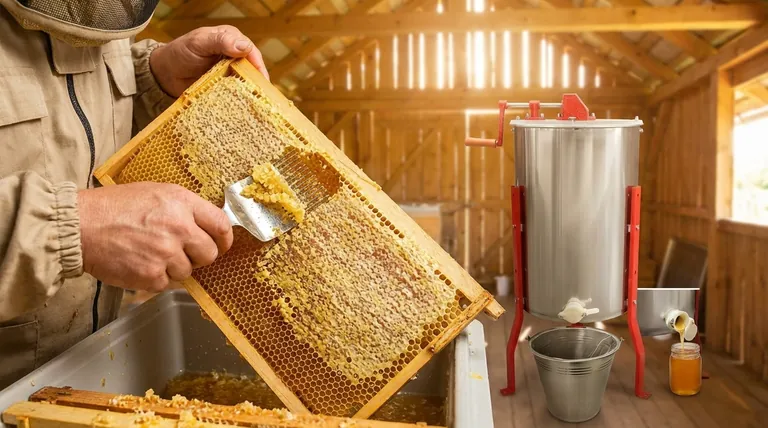The short answer is that it takes approximately 15 to 20 minutes to spin the honey out of a batch of 2 to 4 frames using a common manual extractor. However, this simple number represents only a fraction of the total time and effort required for a honey harvest. The spinning process itself is just one step in a much larger workflow.
The time it takes to spin a single frame is a misleading metric. The true time commitment for honey extraction is found in the entire process, from removing bees from the hive to preparing the frames and filtering the final product.

The Two Phases of Honey Extraction
Thinking about honey extraction is best broken into two distinct phases: preparation and mechanical extraction. For most beekeepers, especially those new to the craft, the preparation phase is where the vast majority of time is spent.
Phase 1: Preparation (The Real Time-Sink)
Before your frames ever see an extractor, a significant amount of work must be done. This is often the most labor-intensive and time-consuming part of the harvest.
Removing Bees from Frames
First, you must get the bees off the honey-filled frames. This can be done with a simple bee brush, but for multiple hives, many beekeepers use a bee escape board, which takes time to work effectively.
Transporting the Frames
Once the bees are removed, the frames must be moved to your processing area (often called a "honey house," which could be a dedicated shed or a clean kitchen). They must be kept in a sealed, bee-proof box to prevent robbing from other bees.
Uncapping the Honeycombs
This is the true bottleneck of the entire process. Each cell of honey is sealed with a wax capping by the bees. To get the honey out, you must manually slice or scrape off these cappings with a hot knife, uncapping fork, or roller. This step requires patience and care.
The Mechanical Extraction Process
Only after the frames are fully prepared and uncapped can they be placed in the extractor for spinning. The time this takes depends heavily on the equipment you use.
The Manual Extractor
A hand-cranked, manual extractor typically holds 2 to 4 frames. The 15-to-20-minute time frame involves spinning the frames to extract honey from the first side, then manually flipping them to spin out the second side.
The Bottleneck Isn't the Extractor
An efficient beekeeper works in a cycle. While one batch of frames is spinning in the extractor, you are busy uncapping the next batch. The speed of the extractor is rarely the limiting factor; your ability to uncap frames quickly is what sets the pace for the day.
Understanding the Trade-offs
The total time for your honey harvest day can vary dramatically based on a few key variables.
Your Equipment
A 4-frame manual extractor is a great starting point for a hobbyist. However, a larger, motorized radial extractor can hold 20 or more frames and extract them much faster, but represents a significant financial investment.
Your Experience Level
An experienced beekeeper with a well-organized workflow will be exponentially faster than a beginner. Skills like efficiently uncapping combs without wasting honey or damaging the comb are developed over time.
The Number of Frames
The more frames you have to process, the longer the day will be. However, your time-per-frame often decreases with volume as you get into a rhythm and benefit from batching tasks together.
How to Estimate Your Honey Harvest Day
Instead of focusing on the time per frame, it's more helpful to think about the entire scope of the project based on your goals.
- If you are a hobbyist with one or two hives: Plan for a full half-day for your first harvest. The 15-20 minute spin time for a few frames is a minor part of a process that includes hive work, uncapping, and cleanup.
- If you are planning to scale up your operation: Your primary time-saving investment is not just a faster extractor, but a more efficient uncapping system. This is where the real bottleneck occurs.
Ultimately, focus on creating an efficient workflow from the hive to the jar, and the extraction time will become a seamless part of a rewarding process.
Summary Table:
| Stage | Estimated Time | Key Factor |
|---|---|---|
| Preparation (Uncapping, etc.) | Major time-sink | Skill & tools are key |
| Mechanical Spinning (2-4 frames) | 15-20 minutes | Type of extractor used |
| Total Harvest (Small-scale) | Half-day | Number of frames & experience |
Ready to streamline your honey harvest?
At HONESTBEE, we supply commercial apiaries and beekeeping equipment distributors with the wholesale-focused tools needed for efficiency. From high-capacity radial extractors to professional uncapping systems, our equipment is designed to eliminate bottlenecks and maximize your yield.
Contact our wholesale team today to discuss how we can support your operation's growth and profitability.
Visual Guide

Related Products
- 2 Frame Stainless Steel Manual Honey Spinner Extractor for Beekeeping
- HONESTBEE 72 Frame Industrial Electric Honey Extractor for Beekeeping
- 6 Frame Manual Stainless Steel Honey Extractor Beekeeping Equipment
- HONESTBEE 8 Frame Electric and Manual Three Use Honey Extractor
- Commercial Electric 12 Frame Honey Extractor Spinner Motorized Honey Extractor
People Also Ask
- How can a pressure washer be used to clean a honey extractor? A Guide to Safe and Efficient Cleaning
- What are some tips for using a honey extractor effectively? Maximize Your Honey Yield and Protect Your Comb
- How does centrifugation work in honey extraction? The Sustainable Method for Modern Beekeepers
- How do beekeepers harvest honey from the honey super? A Step-by-Step Guide to Efficient Extraction
- What are the advantages of tangential honey extractors? Gentle, Affordable Honey Extraction for Your Apiary



















